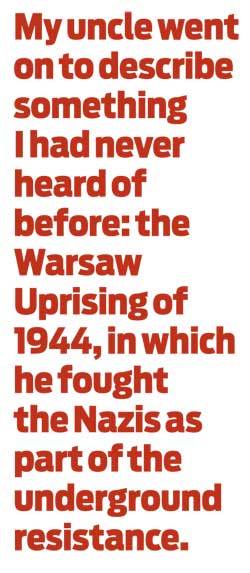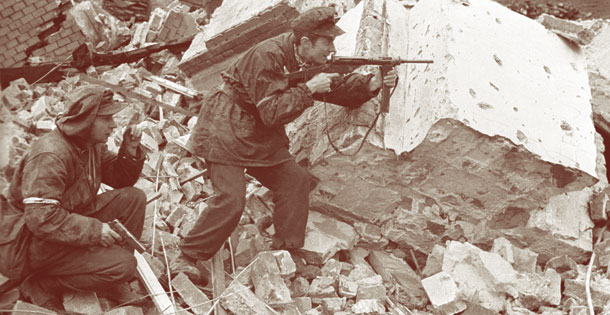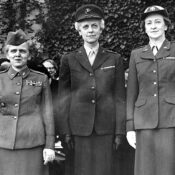As a child in the New Jersey suburbs in the 1970s, I grew up hearing harrowing tales of the Holocaust, often while playing in the backyards of the grandchildren of survivors. In the summer, glimpses of numbered tattoos peeked from loose clothing, permanent proof of what this generation had gone through, sometimes leading to reluctant conversations against the watery backdrop of sprinklers, iced tea, and swimming pools.
I was raised in a non-Jewish family in a largely Jewish suburban neighborhood. Come December, our house was among the few on the street with a Christmas tree. The holiday season was when our Polish-born uncle Eddie, who had married into the family via my aunt RoseAnn, would come to visit. He too had stories of the Nazis. The most vivid was his escape from a work camp by hiding inside the wheel carriage of a departing train.
Even with his brush with the Nazis, I think we dismissed his stories because we knew they were not Jewish tales; they lacked the gravity of the stories our neighbors’ grandparents told. Nothing in our schoolbooks backed up his description of the Polish experience during World War II.
The stories stopped when I was 12, the year my uncle divorced my aunt. Though I would see him briefly at my aunt’s and my father’s funerals, 34 years would pass before I would spend any serious time with him, this time in his hometown of Warsaw.
My uncle and I share the same birthday, and as he aged, I decided I would try to use the day to reconnect by calling him. The journalist in me, having covered horrific events in today’s wars in Iraq and Afghanistan, also wanted to sort out his time under the Nazis, always knowing there was more to it than what he told us. My uncle was a teenager when the war ended, and, at 86, he is among the youngest of those still able to recall a period rapidly slipping out of living memory.
When I called my uncle on our shared birthday in early 2014, mentioning I wanted to formally record his life in Poland, he told me he would soon be back in Warsaw “for the 70th anniversary of the uprising.”
He added, “The government is inviting me to come and be honored for being in the resistance.” I thought for sure my uncle had gone senile. The Warsaw Ghetto Uprising was in 1943, and the 70th anniversary commemorations had come and gone. My uncle went on to describe something I had never heard of before: the Warsaw Uprising of 1944, in which he fought as part of the underground resistance.
No, my uncle was not senile. I was simply undereducated. The Warsaw Uprising — when the entire capital rose up against the Nazis, resulting in the destruction of 85 percent of the city — was simply not something Americans are taught. It is instead the 1943 Warsaw Ghetto Uprising that we learn about in our schoolbooks and via broadcasts like Holocaust and movies like The Pianist.
I was newly proud of my estranged uncle, and I vowed to travel to Poland with him, to hear the stories where they happened, rather than in a New Jersey living room. Not only had he escaped the Nazis, but he had also fought against them in Poland’s resistance, or Armia Krajowa.
Last summer, in Warsaw, at the sites and memorials where contemporary Polish politicians celebrated Eddie and his surviving compatriots [see “Freedom Fighters”], my uncle’s stories began to align into proper sequence. He is one of perhaps 3,000 surviving Polish resistance fighters, about 700 of whom live outside of Poland. While he now goes by Edward Sutton, his Polish name is Edward Sucholski. His resistance code name was Czarny, or Black. One story my uncle told me was of a shootout on Brzozowa Street near Warsaw’s Old Town close to the Vistula River, at some point on August 31, 1944. From a second-story window, he and another resistance fighter battled German soldiers who were in the basement of a nearby building. Few resistance soldiers had weapons, but my uncle had a Schmeisser, an automatic pistol. My uncle said he and the other fighter were fighting from the second floor of what was called the professor’s house, an assembly site for the resistance. “I was shooting from 200 feet away, but I never knew if I killed anyone.”
He and the other fighter retreated. My uncle remembers fleeing along the Vistula into a sewer with other fighters, Germans throwing grenades in after them. He told me, “After that I couldn’t hear for a couple of days from the explosions.” Inside the sewers, there were masses of people, sloshing through the water. “We were just so many of us,” he said, adding, “we were lucky we came out alive.” He made his way to the Kampinos Forest, where he gave up his gun to another resistance fighter.
After the uprising had been put down, my uncle surrendered and was loaded into a cattle wagon, under the watchful gaze of “a German soldier on each rooftop with a machine gun,” he said. Dachau was his first stop, yet he downplayed this, saying he and his father were there only a week “for sorting” before moving to another work camp in Germany. My step-aunt Teresa who came with us explained, “When you came in to the camp, you went one of two ways: either up the chimney or to work. Thanks God, Eddie went to work.”
It was how he, his brother, and his father survived.
They escaped on Christmas Eve, 1944. “We lied on the beams of the train, trying to make ourselves as invisible as possible,” he said.
I wondered if the date was chosen with the knowledge that the Germans would be drunk. Instead, he said, “No, it was snowing, so we knew they wouldn’t take the trouble to look for us.”
My uncle didn’t make it back to Poland. The train only got him to Augsburg, near Munich, ironically close to Dachau where he had first arrived. There, he and his father pretended to be displaced German Poles. After the Americans liberated this part of Germany, he went to Italy, joining the Polish army there, and later was sent to the United Kingdom. After the war, he had the option to relocate to Palestine, a surprise to me as he is not Jewish, but young Catholic Poles were relocating to orphanages there. In 1951 he finally found true freedom here in the United States, arriving via an El Al flight from London to New York’s Idlewild Airport, now known as JFK.
The intermingling of Jews and Catholics was apparent as we visited his street, inside of what had once been the Jewish ghetto. The Chinese Embassy now sits over his long gone childhood home on Franciszkanska Street, near the ghetto dividing line. Warsaw was almost 40 percent Jewish then, but “they took the Jews away from us, we weren’t allowed to live with them,” my uncle said, including his first girlfriend, Rifka, whose fate he does not know. He lifted his hands above his head, curling his fingers into balls, and twisted them back and forth, saying, “They built a 10-foot wall around them and covered it with barbed wire.” Though he had revisited Poland many times, he had not returned to his street since 1944.
 Why is their historical struggle shrouded in such darkness? Pawel Ukielski, the vice director of the Warsaw Uprising Museum, blamed a variety of circumstances. “The Warsaw Uprising was not convenient for anybody to talk about for a long time,” he said, explaining that the Russians — expected to come to the assistance of the resistance fighters — instead camped outside of Warsaw, allowing the Germans to destroy the Polish capital. Their cold calculation was that a devastated country would be easier to occupy at the end of the war. Western Europe and the United States don’t come out much better in this story; they also refused to recognize the exiled Polish government after the war, since the Allied plan was to cede what was left of Poland to the Soviets.
Why is their historical struggle shrouded in such darkness? Pawel Ukielski, the vice director of the Warsaw Uprising Museum, blamed a variety of circumstances. “The Warsaw Uprising was not convenient for anybody to talk about for a long time,” he said, explaining that the Russians — expected to come to the assistance of the resistance fighters — instead camped outside of Warsaw, allowing the Germans to destroy the Polish capital. Their cold calculation was that a devastated country would be easier to occupy at the end of the war. Western Europe and the United States don’t come out much better in this story; they also refused to recognize the exiled Polish government after the war, since the Allied plan was to cede what was left of Poland to the Soviets.
Today, the importance of remembrance has finally trumped the silence over collective guilt. “We are proud that Warsaw was the city of two uprisings. Both of them were unique,” said Ukielski. “We know what happened to Warsaw during the Second World War. It lost almost half of its pre-war population. It lost the whole Jewish population. It was a great loss, a loss of part of our identity. So this is not the question that one such loss should be better known or worse known, we want both of them to be known all over the world.”
I have found, after spending time with my uncle in Warsaw who lived to see both uprisings, that I too know them both better than I ever would have before.
Editor’s note: Portions of this article were previously published in Tablet magazine.
Click here to read a true story from the Post archives about the heroic warriors of the Polish underground.
—
Michael Luongo’s “The World War II Struggle That Time Forgot” won a 2015 North American Travel Journalists Association Gold Prize.
Become a Saturday Evening Post member and enjoy unlimited access. Subscribe now




Comments
Thank you Michael Luongo and your uncle for affirming the stories I heard
as a child from my uncles and extended family.
In re the question: are there any books about this. Yes. This and many more about the relatively unknown story of what happened in Poland in WWII. I hope the editors will allow this link to bibliography of some of the books. My personal favorites are “A Question of Honor” and “The Eagle Unbowed”. Thanks once more to the Saturday Evening Post for the three superb articles in the July/August edition!
http://wewillspeakout.blogspot.com/2012/02/wwii-poland-reading-list.html?m=1
Rising 44 by Norman Davies. It’s a great and complete manual.
@lee – of course there are a lot of books about it, unfortunately I know most of them in Polish but if you are not afraid of a long read, there is a great book of a historian Norman Davies: http://www.amazon.com/Rising-44-The-Battle-Warsaw/dp/0143035401
If you would like to know about Warsaw Uprising in general, the Museum of Warsaw Uprising in Warsaw made an excellent website, which is very informative and interactive: http://www.warsawrising.eu/ (switch to English)
Excellent article about something apparently . Are there any books available about this?
Thank God for Michael Luongo who loved his uncle’s stories and learned the truth through his curiosity and wonder, traits essential to a good reporter and writer.